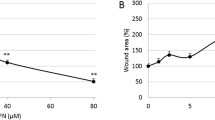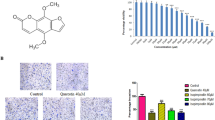Abstract
Hepatocellular carcinoma (HCC) is a highly vascular tumor with high microvessel density and high levels of circulating vascular endothelial growth factor (VEGF). Thus, the angiogenesis pathway is an attractive therapeutic target for HCC. The anti-tumor effects of evodiamine, a quinolone alkaloid isolated from Euodia rutaecarpa (Juss.) Benth. (Rutaceae), were investigated in a mouse xenograft model using BALB/c nude mice, various HCC cell lines (HepG2, SMMC-7721, H22), and human umbilical vein endothelial cells (HUVECs). The effects of evodiamine on tumor volumes and weights, levels of tumor markers, angiogenesis in vivo and in vitro, cell viability, and cell migration and invasion were measured, and the mechanism through which its effects are achieved was investigated. Transcriptional regulation of VEGFa via interaction with β-catenin was established by luciferase activity assays and electrophoretic mobility shift assays. In a subcutaneous H22 xenograft model, evodiamine inhibited tumor growth and reduced serum tumor markers and the levels of β-catenin and VEGFa. It also blocked VEGF-induced angiogenesis in a Matrigel plug assay. Evodiamine suppressed cellular proliferation, invasion, and migration and inhibited tube formation of HUVECs. Moreover, in a concentration-dependent manner, evodiamine reduced the number of capillary sprouts from Matrigel-embedded rat thoracic aortic rings. Also, evodiamine suppressed various biomarkers of angiogenesis and the expression of β-catenin. Evodiamine decreased β-catenin levels activated by LiCl, which led to reduced expression of VEGFa. In addition, β-catenin interacted with VEGFa and transcriptionally regulated VEGFa, an effect inhibited by evodiamine in HCCs. Moreover, in an SMMC-7721 xenograft model, evodiamine suppressed tumor growth, various biomarkers of angiogenesis, and the levels of β-catenin and VEGFa. Evodiamine has anti-tumor effects on HCCs through inhibiting β-catenin, which interacts with and reduces VEGFa expression, thus inhibiting angiogenesis. These results indicate that evodiamine, which inhibits cellular invasion and migration and blocks angiogenesis, is a potential therapeutic agent for HCCs.







Similar content being viewed by others
Abbreviations
- HCC:
-
Hepatocellular carcinoma
- VEGF:
-
Vascular endothelial growth factor
- HUVECs:
-
Human umbilical vein endothelial cells
- DMEM:
-
Dulbecco’s modified Eagle medium
- FBS:
-
Fetal bovine serum
- MTT:
-
3-(4,5-Dimethylthiazol-2-yl)-2,5-diphenyl tetrazolium bromide
- IHC:
-
Immunohistochemical
- DAB:
-
3,3-Diaminobenzidine tetrahydrochloride
- SDS-PAGE:
-
Sodium dodecyl sulfate-polyacrylamide gel electrophoresis
- PVDF:
-
Polyvinylidene fluoride
- BSA:
-
Bovine serum albumin
- HRP:
-
Horseradish peroxidase
- AFP:
-
Alpha fetal protein
- TSGF:
-
Tumor-specific growth factor
References
Adams M, Wube AA, Bucar F, Bauer R, Kunert O, Haslinger E. Quinolone alkaloids from evodia rutaecarpa: a potent new group of antimycobacterial compounds. Int J Antimicrob Agents. 2005;26:262–4.
Ko JS, Rho MC, Chung MY, Song HY, Kang JS, Kim K, et al. Quinolone alkaloids, diacylglycerol acyltransferase inhibitors from the fruits of evodia rutaecarpa. Planta Med. 2002;68:1131–3.
Tang Y, Wu K, Feng X, Huang L. [synthesis and bioaction of 2-alkyl-4(1h)-quinolone]. Yao Xue Xue Bao. 1998;33:121–7.
Zhang PT, Pan BY, Liao QF, Yao MC, Xu XJ, Wan JZ, et al. Simultaneous quantification of limonin, two indolequinazoline alkaloids, and four quinolone alkaloids in evodia rutaecarpa (juss.) benth by hplc-dad method. J Anal Methods Chem. 2013;2013:827361.
Liu R, Chu X, Sun A, Kong L. Preparative isolation and purification of alkaloids from the chinese medicinal herb evodia rutaecarpa (juss.) benth by high-speed counter-current chromatography. J Chromatogr A. 2005;1074:139–44.
Adams M, Kunert O, Haslinger E, Bauer R. Inhibition of leukotriene biosynthesis by quinolone alkaloids from the fruits of evodia rutaecarpa. Planta Med. 2004;70:904–8.
Hamasaki N, Ishii E, Tominaga K, Tezuka Y, Nagaoka T, Kadota S, et al. Highly selective antibacterial activity of novel alkyl quinolone alkaloids from a chinese herbal medicine, gosyuyu (wu-chu-yu), against helicobacter pylori in vitro. Microbiol Immunol. 2000;44:9–15.
Adams M, Mahringer A, Kunert O, Fricker G, Efferth T, Bauer R. Cytotoxicity and p-glycoprotein modulating effects of quinolones and indoloquinazolines from the chinese herb evodia rutaecarpa. Planta Med. 2007;73:1554–7.
Huang X, Li W, Yang XW. New cytotoxic quinolone alkaloids from fruits of evodia rutaecarpa. Fitoterapia. 2012;83:709–14.
Bak EJ, Park HG, Kim JM, Yoo YJ, Cha JH. Inhibitory effect of evodiamine alone and in combination with rosiglitazone on in vitro adipocyte differentiation and in vivo obesity related to diabetes. Int J Obes (Lond). 2010;34:250–60.
Ko HC, Wang YH, Liou KT, Chen CM, Chen CH, Wang WY, et al. Anti-inflammatory effects and mechanisms of the ethanol extract of evodia rutaecarpa and its bioactive components on neutrophils and microglial cells. Eur J Pharmacol. 2007;555:211–7.
Shyu KG, Lin S, Lee CC, Chen E, Lin LC, Wang BW, et al. Evodiamine inhibits in vitro angiogenesis: implication for antitumorgenicity. Life Sci. 2006;78:2234–43.
Zhang C, Fan X, Xu X, Yang X, Wang X, Liang HP. Evodiamine induces caspase-dependent apoptosis and s phase arrest in human colon lovo cells. Anticancer Drugs. 2010;21:766–76.
Wang C, Li S, Wang MW. Evodiamine-induced human melanoma a375-s2 cell death was mediated by pi3k/akt/caspase and fas-l/nf-kappab signaling pathways and augmented by ubiquitin-proteasome inhibition. Toxicol In Vitro. 2010;24:898–904.
Yang J, Wu LJ, Tashino S, Onodera S, Ikejima T. Reactive oxygen species and nitric oxide regulate mitochondria-dependent apoptosis and autophagy in evodiamine-treated human cervix carcinoma hela cells. Free Radic Res. 2008;42:492–504.
Fei XF, Wang BX, Li TJ, Tashiro S, Minami M, Xing DJ, et al. Evodiamine, a constituent of evodiae fructus, induces anti-proliferating effects in tumor cells. Cancer Sci. 2003;94:92–8.
Kan SF, Huang WJ, Lin LC, Wang PS. Inhibitory effects of evodiamine on the growth of human prostate cancer cell line lncap. Int J Cancer J Int Du Cancer. 2004;110:641–51.
Ogasawara M, Matsubara T, Suzuki H. Inhibitory effects of evodiamine on in vitro invasion and experimental lung metastasis of murine colon cancer cells. Biol Pharm Bull. 2001;24:917–20.
Ogasawara M, Matsubara T, Suzuki H. Screening of natural compounds for inhibitory activity on colon cancer cell migration. Biol Pharm Bull. 2001;24:720–3.
Yang J, Cai X, Lu W, Hu C, Xu X, Yu Q, et al. Evodiamine inhibits stat3 signaling by inducing phosphatase shatterproof 1 in hepatocellular carcinoma cells. Cancer Lett. 2013;328:243–51.
Kohn EC, Alessandro R, Spoonster J, Wersto RP, Liotta LA. Angiogenesis: role of calcium-mediated signal transduction. Proc Natl Acad Sci U S A. 1995;92:1307–11.
Belotti D, Vergani V, Drudis T, Borsotti P, Pitelli MR, Viale G, et al. The microtubule-affecting drug paclitaxel has antiangiogenic activity. Clin Cancer Res. 1996;2:1843–9.
Cai T, Fassina G, Morini M, Aluigi MG, Masiello L, Fontanini G, et al. N-acetylcysteine inhibits endothelial cell invasion and angiogenesis. Laboratory Investigation. 1999;79:1151–9.
Singh AK, Seth P, Anthony P, Husain MM, Madhavan S, Mukhtar H, et al. Green tea constituent epigallocatechin-3-gallate inhibits angiogenic differentiation of human endothelial cells. Arch Biochem Biophys. 2002;401:29–37.
Ishikawa F, Miyazono K, Hellman U, Drexler H, Wernstedt C, Hagiwara K, et al. Identification of angiogenic activity and the cloning and expression of platelet-derived endothelial cell growth factor. Nature. 1989;338:557–62.
Hall RA, Lefkowitz RJ. Regulation of g protein-coupled receptor signaling by scaffold proteins. Circ Res. 2002;91:672–80.
Holnthoner W, Pillinger M, Groger M, Wolff K, Ashton AW, Albanese C, et al. Fibroblast growth factor-2 induces lef/tcf-dependent transcription in human endothelial cells. J Biol Chem. 2002;277:45847–53.
Zhang F, Cheng J, Hackett NR, Lam G, Shido K, Pergolizzi R, et al. Adenovirus e4 gene promotes selective endothelial cell survival and angiogenesis via activation of the vascular endothelial-cadherin/akt signaling pathway. J Biol Chem. 2004;279:11760–6.
Schafer R, Abraham D, Paulus P, Blumer R, Grimm M, Wojta J, et al. Impaired ve-cadherin/beta-catenin expression mediates endothelial cell degeneration in dilated cardiomyopathy. Circulation. 2003;108:1585–91.
Nicosia RF, Ottinetti A. Modulation of microvascular growth and morphogenesis by reconstituted basement membrane gel in three-dimensional cultures of rat aorta: a comparative study of angiogenesis in matrigel, collagen, fibrin, and plasma clot. Vitro Cell Dev Biol. 1990;26:119–28.
Malinda KM. In vivo matrigel migration and angiogenesis assays. Methods Mol Med. 2001;46:47–52.
Tu K, Zheng X, Zan X, Han S, Yao Y, Liu Q. Evaluation of fbxw7 expression and its correlation with the expression of c-myc, cyclin e and p53 in human hepatocellular carcinoma. Hepatol Res. 2012;42:904–10.
Isomoto H, Mott JL, Kobayashi S, Werneburg NW, Bronk SF, Haan S, et al. Sustained il-6/stat-3 signaling in cholangiocarcinoma cells due to socs-3 epigenetic silencing. Gastroenterology. 2007;132:384–96.
He X, Xu Z, Wang B, Zheng Y, Gong W, Huang G, et al. Upregulation of thrombomodulin expression by activation of farnesoid x receptor in vascular endothelial cells. Eur J Pharmacol. 2013;718:283–9.
Reiter MJ, Costello JE, Schwope RB, Lisanti CJ, Osswald MB. Review of commonly used serum tumor markers and their relevance for image interpretation. J Comput Assist Tomogr. 2015;39:825–34.
Yang XW, Zhang H, Li M, Du LJ, Yang Z, Xiao SY. Studies on the alkaloid constituents of evodia rutaecarpa (juss) benth var. Bodinaieri (dode) huang and their acute toxicity in mice. J Asian Nat Prod Res. 2006;8:697–703.
Siveen KS, Ahn KS, Ong TH, Shanmugam MK, Li F, Yap WN, et al. Y-tocotrienol inhibits angiogenesis-dependent growth of human hepatocellular carcinoma through abrogation of akt/mtor pathway in an orthotopic mouse model. Oncotarget. 2014;5:1897–911.
Jemal A, Bray F, Center MM, Ferlay J, Ward E, Forman D. Global cancer statistics. CA Cancer J Clin. 2011;61:69–90.
Otrock ZK, Mahfouz RA, Makarem JA, Shamseddine AI. Understanding the biology of angiogenesis: review of the most important molecular mechanisms. Blood Cells Mol Dis. 2007;39:212–20.
Gao W, Chang G, Wang J, Jin W, Wang L, Lin Y, et al. Inhibition of k562 leukemia angiogenesis and growth by selective na+/h + exchanger inhibitor cariporide through down-regulation of pro-angiogenesis factor vegf. Leuk Res. 2011;35:1506–11.
Bishayee A, Darvesh AS. Angiogenesis in hepatocellular carcinoma: a potential target for chemoprevention and therapy. Curr Cancer Drug Targets. 2012;12:1095–118.
Subramaniam A, Shanmugam MK, Perumal E, Li F, Nachiyappan A, Dai X, et al. Potential role of signal transducer and activator of transcription (stat)3 signaling pathway in inflammation, survival, proliferation and invasion of hepatocellular carcinoma. Biochim Biophys Acta. 1835;2013:46–60.
Reuben SC, Gopalan A, Petit DM, Bishayee A. Modulation of angiogenesis by dietary phytoconstituents in the prevention and intervention of breast cancer. Mol Nutr Food Res. 2012;56:14–29.
Tanaka S, Arii S. Molecular targeted therapies in hepatocellular carcinoma. Semin Oncol. 2012;39:486–92.
Carmeliet P, Jain RK. Principles and mechanisms of vessel normalization for cancer and other angiogenic diseases. Nat Rev Drug Discov. 2011;10:417–27.
Ferrara N, Gerber HP, LeCouter J. The biology of vegf and its receptors. Nat Med. 2003;9:669–76.
Duh EJ, Yang HS, Haller JA, De Juan E, Humayun MS, Gehlbach P, et al. Vitreous levels of pigment epithelium-derived factor and vascular endothelial growth factor: implications for ocular angiogenesis. Am J Ophthalmol. 2004;137:668–74.
Gasparini G, Longo R, Toi M, Ferrara N. Angiogenic inhibitors: a new therapeutic strategy in oncology. Nat Clin Pract Oncol. 2005;2:562–77.
Rafii S, Lyden D, Benezra R, Hattori K, Heissig B. Vascular and haematopoietic stem cells: novel targets for anti-angiogenesis therapy? Nat Rev Cancer. 2002;2:826–35.
Conway EM, Collen D, Carmeliet P. Molecular mechanisms of blood vessel growth. Cardiovasc Res. 2001;49:507–21.
Ferrara N. Vascular endothelial growth factor and the regulation of angiogenesis. Recent Prog Horm Res. 2000;55:15–35. discussion 35-16.
Cattelino A, Liebner S, Gallini R, Zanetti A, Balconi G, Corsi A, et al. The conditional inactivation of the beta-catenin gene in endothelial cells causes a defective vascular pattern and increased vascular fragility. J Cell Biol. 2003;162:1111–22.
Zhang X, Gaspard JP, Chung DC. Regulation of vascular endothelial growth factor by the wnt and k-ras pathways in colonic neoplasia. Cancer Res. 2001;61:6050–4.
Acknowledgments
The authors wish to thank Donald L. Hill (University of Alabama at Birmingham, USA), an experienced, English-speaking scientific editor for editing.
Author information
Authors and Affiliations
Corresponding author
Ethics declarations
Conflicts of interest
None
Funding
This work was supported by the Natural Science Foundations of China (81273114, 81302467, 81402959), the Postgraduate Innovation Project of Jiangsu province (CXZZ14_0421, CXZZ14_0951, and KYLX15_0974), and the Priority Academic Program Development of Jiangsu Higher Education Institutions (2014).
Additional information
Le Shi and Fan Yang contributed equally.
Rights and permissions
About this article
Cite this article
Shi, L., Yang, F., Luo, F. et al. Evodiamine exerts anti-tumor effects against hepatocellular carcinoma through inhibiting β-catenin-mediated angiogenesis. Tumor Biol. 37, 12791–12803 (2016). https://doi.org/10.1007/s13277-016-5251-3
Received:
Accepted:
Published:
Issue Date:
DOI: https://doi.org/10.1007/s13277-016-5251-3




